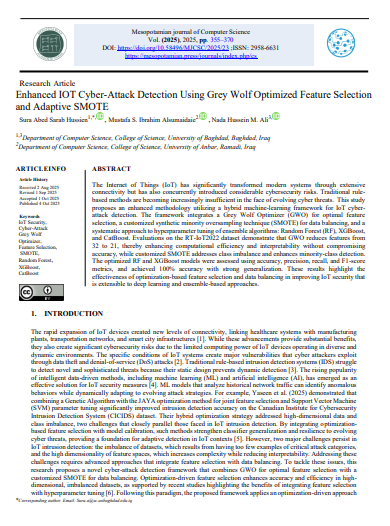Enhanced IOT Cyber-Attack Detection Using Grey Wolf Optimized Feature Selection and Adaptive SMOTE
Main Article Content
Abstract
The Internet of Things (IoT) has significantly transformed modern systems through extensive connectivity but has also concurrently introduced considerable cybersecurity risks. Traditional rule-based methods are becoming increasingly insufficient in the face of evolving cyber threats. This study proposes an enhanced methodology utilizing a hybrid machine-learning framework for IoT cyber-attack detection. The framework integrates a Grey Wolf Optimizer (GWO) for optimal feature selection, a customized synthetic minority oversampling technique (SMOTE) for data balancing, and a systematic approach to hyperparameter tuning of ensemble algorithms: Random Forest (RF), XGBoost, and CatBoost. Evaluations on the RT-IoT2022 dataset demonstrate that GWO reduces features from 32 to 21, thereby enhancing computational efficiency and interpretability without compromising accuracy, while customized SMOTE addresses class imbalance and enhances minority-class detection. The optimized RF and XGBoost models were assessed using accuracy, precision, recall, and F1-score metrics, and achieved 100% accuracy with strong generalization. These results highlight the effectiveness of optimization-based feature selection and data balancing in improving IoT security that is extensible to deep learning and ensemble-based approaches.
Article Details
Issue
Section

This work is licensed under a Creative Commons Attribution 4.0 International License.
How to Cite
References
[1] G. S. Nadella and H. Gonaygunta, “Enhancing Cybersecurity with Artificial Intelligence: Predictive Techniques and Challenges in the Age of IoT,” International Journal of Science and Engineering Applications, vol. 13, no. 04, pp. 30–33, 2024.
[2] J. Deogirikar and A. Vidhate, “Security attacks in IoT: A survey,” in 2017 International Conference on I-SMAC (IoT in Social, Mobile, Analytics and Cloud) (I-SMAC), IEEE, 2017, pp. 32–37.
[3] A. A. Nafea, M. M. Hamdi, B. saad Abdulhakeem, A. T. Shakir, M. S. I. Alsumaidaie, and A. M. Shaban, “Detection Systems for Distributed Denial-of-Service (DDoS) Attack Based on Time Series: A Review,” in 2024 21st International Multi-Conference on Systems, Signals & Devices (SSD), IEEE, 2024, pp. 43–48.
[4] A. H. Salem, S. M. Azzam, O. E. Emam, and A. A. Abohany, “Advancing cybersecurity: A comprehensive review of AI-driven detection techniques,” Journal of Big Data, vol. 11, no. 1, p. 105, 2024.
[5] Yaseen, M. G., Ali, A. H., & Alajanbi, M., “An Enhanced Hybrid Genetic-JAYA Algorithm for Feature Selection and SVM Parameter Optimization in Intrusion Detection Systems: Evaluation on the CICIDS Dataset”. SHIFRA, 2025, 98-109. https://doi.org/10.70470/SHIFRA/2025/006.
[6] U. Inayat, M. F. Zia, S. Mahmood, H. M. Khalid, and M. Benbouzid, “Learning-Based Methods for Cyber Attack Detection in IoT Systems: A Survey on Methods, Analysis, and Future Prospects,” 2022. doi: 10.3390/electronics11091502.
[7] Li, Y., Lin, H., Liu, Y., & Zhang, X. (2024). "A Lightweight Federated Learning Framework for IoT Intrusion Detection Using Attention-Based Neural Networks." IEEE Internet of Things Journal, 11(3), 4512–4525. DOI:
https://doi.org/10.1109/JIOT.2024.1001932.
[8] Zhang, L., Wang, R., & Elhoseny, M. (2024). Hybrid attention-based LSTM-CNN model for detecting cyber threats in IoT networks. IEEE Transactions on Network and Service Management, 21(1), 75–88. DOI: https://doi.org/10.1109/TNSM.2024.1001743.
[9] A. Gueriani, H. Kheddar, and A. C. MAZARI, Enhancing IoT Security with CNN and LSTM-Based Intrusion Detection Systems. 2024. doi: 10.48550/arXiv.2405.18624.
[10]T. Subalaxmi, R. Akalya, R. Kaviya, V. Santhosh, and P. Ramalingam, Enhancing Cyber-Attack Detection in IoT Networks through Deep Reinforcement Learning. 2024. doi: 10.1109/ICKECS61492.2024.10616565.
[11] A. Hammad, M. Falih, S. Abd, and R. Ahmed, “Detecting Cyber Threats in IoT Networks: A Machine Learning Approach,” International Journal of Computing and Digital Systems, vol. 17, pp. 1–25, Dec. 2024, doi: 10.12785/ijcds/1571020041.
[12] Thaker Nay, “Enhancing IoT Security with AI-Driven Hybrid Machine Learning and Neural Network-Based Intrusion Detection System”. Babylonian Journal of Artificial Intelligence, Vol. 2024, 2024, pp 158-167. DOI: 10.58496/BJAI/2024/017.
[13] Almalki, A., Kim, T., & Shaaban, E. (2023). A distributed, lightweight deep learning approach for intrusion detection in resource-constrained IoT environments. Computers & Security, 131, 103191. DOI: https://doi.org/10.1016/j.cose.2023.103191.
[14] Y. Kongsorot, P. Musikawan, P. Aimtongkham, I. You, A. Benslimane, and C. So-In, “An Intrusion Detection and Identification System for Internet of Things Networks Using a Hybrid Ensemble Deep Learning Framework,” IEEE Transactions on Sustainable Computing, vol. PP, Aug. 2023, doi: 10.1109/TSUSC.2023.3303422.
[15] A. G. M. Mengara, Y. Yoo, and V. C. M. Leung, “IoTSecUT: Uncertainty-Based Hybrid Deep Learning Approach for Superior IoT Security Amidst Evolving Cyber Threats,” IEEE Internet Things J, 2024.
[16] M. Chemmakha, O. Habibi, and M. Lazaar, “A novel hybrid architecture of conditional tabular generative adversarial network and 1d convolution neural network for enhanced attack detection in IoT systems,” in 2023 Sixth International Conference on Vocational Education and Electrical Engineering (ICVEE), IEEE, 2023, pp. 156–161.
[17] B. S. Sharmila and R. Nagapadma, “Quantized autoencoder (QAE) intrusion detection system for anomaly detection in resource-constrained IoT devices using RT-IoT2022 dataset,” Cybersecurity, vol. 6, pp. 1–15, 2023.
[18] Ž. Vujović, “Classification model evaluation metrics,” International Journal of Advanced Computer Science and Applications, vol. 12, no. 6, pp. 599–606, 2021.
[19] M. S. I. Alsumaidaie, K. M. A. Alheeti, and A. K. Al-Aloosy, “Intelligent Detection System for a Distributed Denial-of-Service (DDoS) Attack Based on Time Series,” in 2023 15th International Conference on Developments in eSystems Engineering (DeSE), IEEE, 2023, pp. 445–450.
[20] G. Naidu, T. Zuva, and E. M. Sibanda, “A review of evaluation metrics in machine learning algorithms,” in Computer Science Online Conference, Springer, 2023, pp. 15–25.
[21] M. Muntean and F.-D. Militaru, “Metrics for evaluating classification algorithms,” in Education, Research and Business Technologies: Proceedings of 21st International Conference on Informatics in Economy (IE 2022), Springer, 2023, pp. 307–317.
[22] M. Lutz, Programming Python. “O’Reilly Media”, Inc., 2011.
